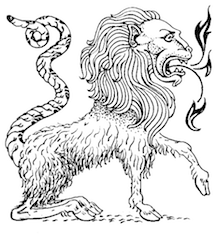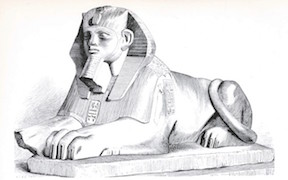Along with indicators like an uptick in climatic disruptions, strides in science may well point to where we are in the period known as the Age of Man.

Drawing of Greek Chimera
Scientific Magazine posted an article on August 18, 2016 with the title, Biologists are close to reinventing the genetic code of life.
The summary of the article reads,
“The term “life hacking” usually refers to clever tweaks that make you more productive. But a team of scientists has come one step closer to the literal meaning: hacking the machinery of life itself. They have designed—though not completely assembled—a synthetic Escherichia coli genome that could use a protein-coding scheme different from the one employed by all known life.”
Completion of this new form of a bacteria is expected to take several more years.
The research is part of a new and potentially lucrative branch of science and engineering known as synthetic biology. In 2011 the same magazine stated that the goal is “the reengineering of cells as industrial machines.”
And if Harvard’s team is successful in “reinventing the genetic code”, the magazine added, then “biotechnology will have a new workhorse cell. And the planet will have a novel life form.”
Designed to Order
Others biotechnologists in Asia, Europe, and North America are taking a slightly different route. Their immediate focus is on new higher life forms dubbed chimeras. A chimera is a mix of animal species or even of humans and animals (aka manimals).

An Egyptian Sphinx
The idea has existed since ancient times. Egyptian Sphinxes are sculptured manimals. The prophetic symbols recorded by Daniel and John in the Bible are examples of chimeras. But, in each case, they were symbolic representations and not real life.
However, now some researchers have already developed actual living chimeras, including manimals. And, others plan to.
One of the first chimeras developed for commercial purposes was a genetically modified salmon. To ramp up farmed salmon growth, a biotech company headquartered in Massachusetts inserted an eel like species gene into the fish.
Though the public remains wary of GMO food, biomedical companies are increasingly finding uses for chimeras.
Issues
Work proceeds in spite of some serious unaddressed questions like, “At what point does a manimal become entitled to, or lose, the legal and ethical considerations accorded human beings”?
Quite a few articles have been written about chimera research.
Back in 2005 National Geographic News posted one titled, “Animal-Human Hybrids Spark Controversy”.
And on January 6, 2016, the MIT Technology Review posted a progress update of sorts, “Human-Animal Chimeras Are Gestating on U.S. Research Farms”.